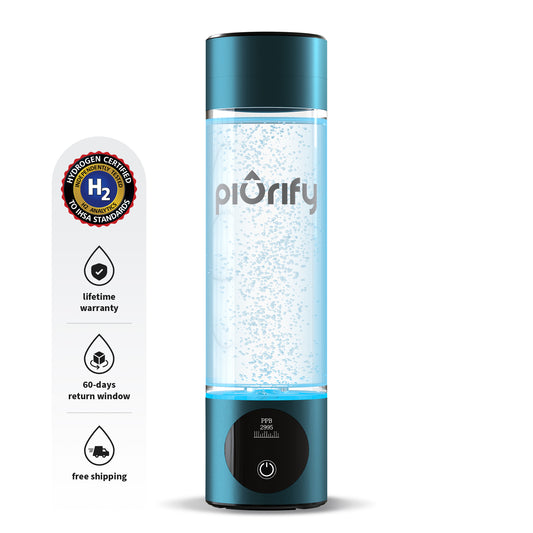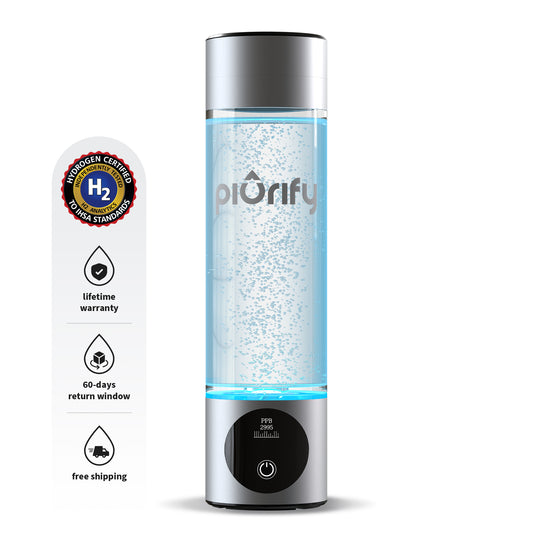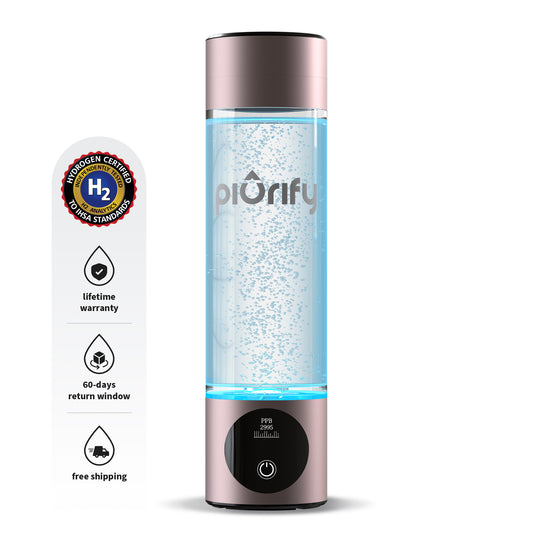9 Types of Water Filters for Your Home
The water filter you choose can make a huge difference to your health – but with so many types of water filters available, how do you know which one is best? In this guide, we’ll explore the most common types of water filters for home use, how they work, their pros and cons, and which might be right for your needs.
Here Are The Top 9 Types of Water Filters:
- Activated Carbon
- Ion Exchange
- Reverse Osmosis (RO)
- Mechanical Filters
- Ultraviolet (UV)
- Ceramic Filters
- Infrared Filters
- Distillation
- Ultrafiltration (UF)
What Is a Water Filter?
A water filter is a device that removes impurities and contaminants from water, which makes it safer, cleaner and more pleasant to drink. They work by either:
- Physically trapping particles
- Chemically neutralising harmful substances
- Using other processes like UV light or reverse osmosis to purify water
Depending on the type of filter, they can remove:
- Sediment like dirt, rust, and sand
- Chemical contaminants such as chlorine, pesticides, and VOCs
- Heavy metals like lead and mercury
- Microorganisms like bacteria, viruses, and parasites

Some water filters may also remove microplastics, but many don't have the fine filtration needed to capture particles that small.
Water filters can come in various forms, from pitchers to whole-house filtration units. They're used in households around the world to improve the quality of tap water and protect against potential health risks.
Signs You Need a Water Filter
Not sure whether it’s time to invest in a water filter? Even if your tap water looks clean, it may still contain hidden contaminants or substances that affect its taste, safety, or your health over time.
Here are some common signs that you might benefit from a water filter:
- A bad taste or smell
- Cloudy water or discoloration
- Limescale buildup on appliances
- Sensitive skin after showering
- Local water quality concerns (check your city’s report)
Types of Water Filters
Here are the different types of filters used to purify water, with a breakdown of how each works, what they remove, and the pros and cons:
1 - Activated Carbon
Activated carbon filters are made from organic materials such as coconut shells or charcoal that have been heat-treated to create a highly porous surface. These pores attract and trap contaminants through adsorption.
They are often used in pitcher filters, faucet-mounted filters, and refrigerator water systems.
Pros:
- Affordable and widely available
- Great for improving taste and smell
- Easy to install and maintain
- Often used in gravity-based filter pitchers
Cons:
- Doesn’t remove dissolved solids or heavy metals
- Limited lifespan – needs regular replacement
- Gravity-based filters require frequent cartridge changes and slower flow rates
- Coarser filtration due to lack of power means they can’t remove fine contaminants like microplastics or heavy metals
- Not ideal for highly contaminated water
2 - Ion Exchange
Ion exchange filters work by swapping out unwanted mineral ions, such as calcium and magnesium, with sodium or hydrogen ions. This effectively softens the water. This type of filter is often found in water softeners and helps reduce scale buildup in pipes and appliances.
Pros:
- Great for softening hard water
- Can protect appliances from scale damage
Cons:
- Can add sodium to water
- Doesn't remove chemicals or microorganisms
3 - Reverse Osmosis (RO)
RO filters move water through a semipermeable membrane to remove impurities and contaminants, including microorganisms, heavy metals and chemicals. These are often part of multi-stage systems, combining sediment and carbon filtration for thorough purification.
Pros:
- Removes up to 99% of contaminants
- Excellent for drinking and cooking water
Cons:
- Removes beneficial minerals like magnesium and calcium, which are important for hydration and electrolyte balance.
- Some systems include a remineralisation stage, but the added minerals are synthetic and not equivalent to those naturally found in water.
- Slower filtration rate and higher cost.
- Wastes water during the process.
Note: If you’re considering RO, look for models with a high-efficiency membrane and natural mineral filter as the final stage, but be aware that ‘remineralisation’ doesn’t always replicate nature.
4 - Mechanical Filters
Mechanical filters are ideal for removing sediment. They use a mesh or foam to trap dirt, sand and particles. They’re often rated by micron size – the smaller the micron rating, the finer the filtration. Mechanical filters are often used as pre-filters in combination with other, more advanced systems for full purification.
Pros:
- Simple and cost-effective
- Prevents clogging in other filters
Cons:
- Doesn’t remove chemicals or microbes
- Needs regular cleaning or replacement
5 - Ultraviolet (UV)
UV filters disinfect water by exposing it to ultraviolet light, killing bacteria, viruses, and other microorganisms. They’re usually used alongside other filters since they don’t remove physical particles or chemicals. Pre-filtration is essential to remove sediment before UV treatment, as particles can block the UV light.
Pros:
- Very effective against microbes
- Quick & chemical-free disinfection
Cons:
- Requires electricity
- Doesn’t remove sediment or chemicals
6 - Ceramic Filters
Ceramic filters are usually used in countertop gravity-fed systems with similar flow issues as carbon gravity filters. They feature tiny pores that block bacteria and sediment – and some models are coated with silver to reduce bacterial growth on the filter surface.
Pros:
- Reusable and long-lasting
- Good for basic microbial and sediment filtration
Cons:
- Doesn’t remove viruses, chemicals or heavy metals
- Can clog up if not cleaned
7 - Infrared Filters
Infrared filters use heat and light to change the molecular structure of water, helping to reduce surface tension and soften water. They are often used in combination with other technologies. Infrared filters don’t physically remove contaminants – they're primarily used for softening water, making them perfect for shower filters.
Pros:
- Helps soften water by reducing surface tension
- Can improve the feel of water on skin and hair (especially in showers)
- Works well in combination with other filtration technologies
- No chemicals or additives required
Cons:
- Does not remove contaminants like bacteria, heavy metals, or chemicals
- Not suitable as a standalone solution for drinking water
- Minimal impact on overall water purity
- Benefits are largely limited to water feel rather than health or safety
8 - Distillation
Distillation involves boiling water to create steam. The steam is then condensed into purified water, leaving contaminants behind. It’s highly effective at removing minerals, heavy metals, and microbes. This type of filtration is great for countertop distillers for drinking water.
Pros:
- Very thorough purification
- No need for replacement filters
Cons:
- Slow and energy-intensive
- Removes beneficial minerals
9 - Ultrafiltration (UF)
Ultrafiltration is a membrane-based water purification method that uses extremely fine filters to physically block particles, bacteria, protozoa and some viruses. UF systems are typically used alongside other filters, such as activated carbon, to create multi-stage filtration units that offer broad protection against both physical and chemical contaminants.
Pros:
- Removes bacteria, protozoa and some viruses
- No chemicals required
- Preserves beneficial minerals
- Good flow rate
- Compact and energy-efficient
Cons:
- Does not remove dissolved chemicals like chlorine, pesticides, or heavy metals
- Often needs pre-filtration to avoid clogging with sediment
- Not a standalone solution for chemical contamination
Which Type of Water Filter Is Most Effective?
The most effective water filter depends on what you’re trying to remove. No single filter type removes everything, which is why many filtration systems combine multiple filtration technologies.
Reverse osmosis is often considered the most effective for comprehensive purification. RO filters remove a wide range of contaminants, including:
- Microplastics
- Lead
- Fluoride
- Nitrates
However, they might not be the most convenient or affordable choice for everyday use. If you want something a little more affordable and convenient, you may prefer activated carbon filters or multi-stage filtration systems that combine multiple methods.
If you're looking for a single, powerful solution, a multi-stage system that combines sediment filtration, activated carbon, and reverse osmosis or UV is ideal.
Water Filter Comparison Table
| Filter Type | Removes | Doesn’t Remove | Power Needed | Maintenance | Installation |
|---|---|---|---|---|---|
| Activated Carbon | Chlorine, VOCs, taste, odor | Heavy metals, microbes | No | Moderate (frequent) | No |
| Ion Exchange | Hardness minerals | Chemicals, microbes | No | Low | Yes (softeners) |
| Reverse Osmosis | 99% of contaminants | Nothing, but it removes minerals | Yes | Moderate to high | Yes |
| Mechanical | Sediment | Chemicals, microbes | No | Low | No |
| UV | Bacteria, viruses | Sediment, chemicals | Yes | Low | Yes |
| Ceramic | Bacteria, sediment | Viruses, chemicals, and metals | No | Low (cleanable) | No |
| Infrared | Softens water | All contaminants | Sometimes | Low | No |
| Distillation | Almost everything | Requires electricity, minerals | Yes | Low (clean unit) | No |
| Ultrafiltration | Bacteria, particles, and viruses | Dissolved chemicals, metals | Yes | Moderate | Depends on the model |
Which Is Best for Drinking Water?
If you want to improve your drinking water quality at home, opt for a high-quality activated carbon filter or a multi-stage pitcher. These offer a balance of affordability, convenience, and performance.
If you're concerned about more than just taste – for example, heavy metals or microplastics – a pitcher that combines activated carbon, ultrafiltration, and mineral retention is a great choice, improving your drinking water without complex installation.
Which Water Filter is Best for You?
For most everyday drinking water needs, a multi-stage system combining ultrafiltration and activated carbon is an excellent choice. This setup effectively removes bacteria and some chemicals while preserving beneficial minerals.
Activated carbon improves taste and odor, but has limits. It doesn’t remove heavy metals or microbes well, especially in gravity-fed pitchers that filter slowly and need frequent replacements. Ultrafiltration removes microbes faster and more efficiently without stripping essential minerals.
Reverse osmosis (RO) offers the most thorough purification, but it removes natural minerals, tends to be more expensive, takes up space and requires complex installation.
For most households, ultrafiltration combined with activated carbon offers a balanced, cost-effective and convenient solution.

Ready to Upgrade Your Drinking Water?
Want something convenient and compact?
The PIURIFY Alchemy Automatic Water Filter Pitcher offers multistage activated Carbon and ultrafiltration that removes up to 99.9% of contaminants – perfect for daily hydration.
This pitcher combines multi-stage filtration with modern design and convenience. It removes chlorine, heavy metals, and microplastics, helping you enjoy clean, great-tasting water straight from your fridge or countertop – no plumbing required!
Make the switch to cleaner, better water today — your body (and the planet) will thank you.



